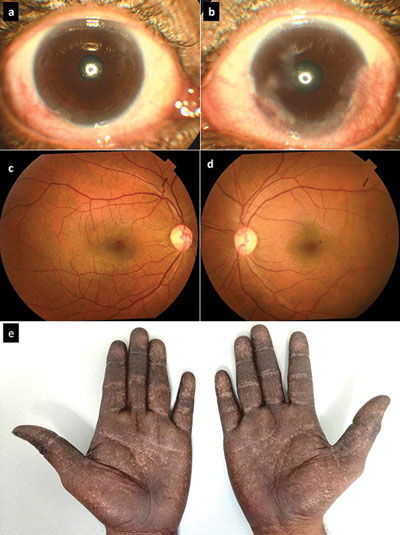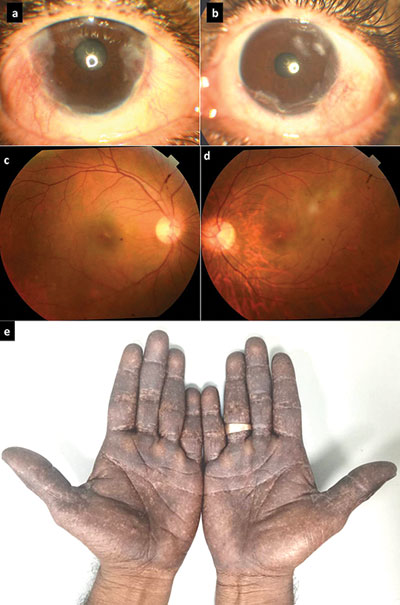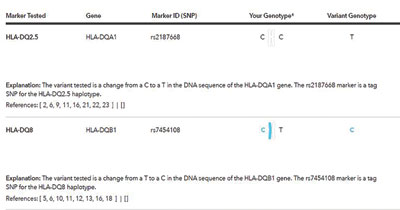Limbal stem cell deficiency seen in celiac disease variant
Ophthalmic manifestations can occur in celiac disease, but this patient did not present with typical features.
Click Here to Manage Email Alerts
Celiac disease is an autoimmune condition that usually presents with intestinal disorders. Ophthalmic manifestations, though, have been noted, and bilateral limbal stem cell deficiency is rarely reported in celiac disease. The ocular manifestations involve retinopathy, cataract, vitamin A deficiency, and pseudotumor cerebri and its related presentations. Here, we report two siblings with ocular features suggestive of limbal stem cell deficiency and dermatological manifestations that led to the detection of celiac gene defect positivity.

Patient and presentation
A 35-year-old man presented to the outpatient department with chief complaints of watering, redness and pain on and off in both eyes for 3 months. His history included skin discoloration since childhood and surgery for bilateral chronic suppurative otitis media. He also had a history of irritable bowel syndrome since childhood, for which he underwent fissure-in-ano surgery.

Source: Dhivya Ashok Kumar, MD, FRCS, FAICO, FICO, Amar Agarwal, MS, FRCS, FRCOphth, and Deepali Velani, MS
On ocular examination, best corrected visual acuity in both eyes was 20/20, N6 with correction. On slit lamp examination, there was bilateral diffuse conjunctival congestion and conjunctivalization of the peripheral cornea involving 7 clock hours with a peripheral corneal opacity. In the left eye, conjunctivalization of the cornea extended from 3 to 9 clock hours with pseudo-pterygium formation (Figures 1a and 1b) with inferior 270° peripheral corneal opacity. The lens was clear and fundus examination was normal (Figures 1c and 1d) in both eyes. Schirmer test was 20 mm in the right eye and 15 mm in the left eye. The patient was noted to have dry skin and hyperpigmentation of the palms, soles and whole body (Figure 1e). Surprisingly, his elder brother also had a similar dermatological presentation as well as ocular findings of conjunctivalization and corneal opacities, suggestive of limbal stem cell deficiency and normal fundus in both eyes (Figures 2a to 2e).
The patient was subsequently referred to a dermatologist, and a skin biopsy was taken from the palm and sole, which showed hyperkeratosis. Gastroenterologist opinion showed no colon polyps or lesions. Investigations including complete blood count, erythrocyte sedimentation rate, C-reactive protein, rheumatoid factor, serum antibody screening (antinuclear antibodies, anti-double-stranded DNA antibodies, antineutrophil cytoplasmic antibodies) and sarcoidosis screening were normal. HLA-DQB1 gene test was positive, suggestive of celiac disease variant. His genetic testing of saliva showed change in HLA-DQ8 haplotype. The variant tested was the change in the T to C in a DNA sequence of the HLA-DQB1 gene (Figure 3). He was then prescribed a short course of topical steroids with lubricants and was reviewed regularly.

Stem cell deficiency
Limbal stem cell deficiency (LSCD) is characterized by a loss or deficiency of the stem cells in the limbus that are vital for repopulation of the corneal epithelium and to the barrier function of the limbus. The etiologies of LSCD can be genetic, acquired or idiopathic. LSCD has been associated with PAX6 gene mutations, which are also implicated in aniridia and Peters anomaly. Other genetic disorders that have been reported with LSCD include ectrodactyly-ectodermal-dysplasia-clefting syndrome, keratitis-ichthyosis-deafness syndrome, dominantly inherited keratitis, Turner syndrome and dyskeratosis congenita. LSCD has also been associated with xeroderma pigmentosa and congenital ichthyosis. So far in the literature, the association of LSCD with celiac disease has not been reported. To the best of our knowledge, this is the first report on the clinical findings of two affected siblings with features consistent with LSCD and associated celiac gene defect positive, with hyperpigmentation in HLA-DQB1 gene variant.
Eye and celiac disease

Vitamin A deficiency in celiac disease due to malabsorption is known for xerophthalmia and ocular surface problems. The same has been proposed for signs of pseudotumor cerebri and retinopathy. The other associations of celiac disease are cataract due to malabsorption in calcium, orbital myositis and uveitis. Central retinal vein occlusion and visual loss due to bioccipital calcification has also been reported. However, our patient did not present with any of the previously reported signs including retinopathy or nyctalopia. Because our patient had the skin manifestation of hyperkeratosis, conditions causing skin pigmentation should also be considered as a differential diagnosis. Moreover, the usual dermatological presentations in celiac disease are skin erythema and rashes, unlike our patient who showed hyperpigmentation.
Diagnosis and management
Clinical diagnosis involves a complete ophthalmic examination, including dry eye diagnostics and fundus examination. Skin biopsy in patients with skin lesions is required, and sibling examination can be performed wherever necessary. Genetic analysis is vital in confirming the diagnosis and ruling out other simulating pathologies. Gastrointestinal screening and gastroenterologist consultation may be required in symptomatic patients. The classic triad of systemic manifestation of celiac disease such as diarrhea, abdominal pain and malabsorption are seen only in 10% to 20%. The presence of HLA-DQ2 and HLA-DQ8 was a commonly identified genetic change in celiac disease. Early evaluation and screening in diagnosed patients can prevent vision-threatening complications. Early-stage LSCD can be managed easily with topical preservative-free lubricants and anti-inflammatory agents. Moderate to severe disease will require further advanced management including surgery. Protective glasses, appropriate diet modification and regular follow-up should be explained to the patient.
Summary
Although eye manifestations in celiac disease are often confined to vitamin A deficiency, our patient did not present with typical features. Nevertheless, celiac disease variants can present with varied ocular manifestations such as limbal stem cell deficiency. The rarity of the case and the uniqueness of the clinical presentation have made us report this case for future interest. We also insist on continuous follow-up in such patients to assess long-term ocular and systemic outcomes.
- References:
- Fernandes M, et al. Eye (Lond). 2004;doi:10.1038/sj.eye.6700717.
- Gao Z, et al. Neuroophthalmology. 2015;doi:10.3109/01658107.2015.1081614.
- Kelly CP, et al. Gastroenterology. 2015;doi:10.1053/j.gastro.2015.01.044.
- Le Q, et al. Ocul Surf. 2018;doi:10.1016/j.jtos.2017.11.002.
- Lewis CD, et al. J Pediatr Ophthalmol Strabismus. 2011;doi:10.3928/01913913-20100318-04.
- Malhi RK, et al. Indian J Ophthalmol. 2018;doi:10.4103/ijo.IJO_351_18.
- Martins TG, et al. Int J Ophthalmol. 2016;doi:10.18240/ijo.2016.01.26.
- For more information:
- Amar Agarwal, MS, FRCS, FRCOphth, is director of Dr. Agarwal’s Eye Hospital and Eye Research Centre. Agarwal is the author of several books published by SLACK Incorporated, publisher of Ocular Surgery News, including Phaco Nightmares: Conquering Cataract Catastrophes, Bimanual Phaco: Mastering the Phakonit/MICS Technique, Dry Eye: A Practical Guide to Ocular Surface Disorders and Stem Cell Surgery and Presbyopia: A Surgical Textbook. He can be reached at 19 Cathedral Road, Chennai 600 086, India; email: aehl19c@gmail.com; website: www.dragarwal.com.
Disclosures: The authors report no relevant financial disclosures.
